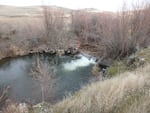The Confederated Tribes of the Umatilla Indian Reservation are close to removing a dam near Pendleton that is doing little except blocking fish. Still, it’s taken 40 years for the tribes and the dam’s owners to get this close to demolition.

Birch Creek flows through the Peterson Dam near Pendleton, Ore., in an undated, provided photo.
Courtesy of Mike Lambert
Mike Lambert, the fish habitat and passage program supervisor for the Confederated Tribes of the Umatilla Indian Reservation, said the tribes have listed the removal of the Peterson Dam on Birch Creek as a priority project since 1984. The tribes expect to remove the privately owned structure by the end of September as a part of a broader effort to clear human-made obstacles from hundreds of river miles.
Larger dam removals might draw more public attention, but Lambert said clearing antiquated dams from smaller rivers and streams can also have a big impact on fish populations.
“We’ve always intended to remove that dam since it’s not used for the purpose it was built for,” Lambert said. “It’s creating a barrier to fish for no purpose right now.”
Standing six feet tall and 35 feet wide, the Peterson Dam pales in comparison to the massive dams installed on the Columbia River. But Birch Creek watershed produces 50% of the summer steelhead population in the entire Umatilla Basin, Lambert said, while coho and Chinook salmon also use the creek to spawn.
Built sometime during the early 20th century, the Peterson Dam used to divert water from Birch Creek to irrigate some nearby farms. A tributary of the Umatilla River, the creek starts a few miles southwest of Pendleton.
The dam removal project has stalled for decades, but not for lack of effort on the tribes’ part, Lambert said.
Besides needing to navigate state bureaucracy, it took time to convince the landowner that clearing the dam wouldn’t hurt the irrigation to an alfalfa farm. Irrigation techniques changed and became more efficient over time, Lambert said, and even though the original owner, Homer Peterson, died in 2018, his estate eventually gave the tribes the green light, when they agreed that removing the dam wouldn’t hurt agriculture.
Lambert said removing the dam is an important move for the tribes.
“Restoring these fish populations not only restores access to fish that the tribe relies on for subsistence and even some level commercial fishing, but it’s also important to their culture as well,” he said.

FILE - The Nixyaawii Governance Center in Mission, Ore., on April 30, 2024.
Antonio Sierra / OPB
Dams across the Northwest have been a boon for agriculture, hydropower and the shipping industry. That’s come at a cost to salmon and other freshwater fish, whose numbers are plummeting as they struggle to navigate obstacles. Salmon have played an important role in the subsistence and cultural life of tribes across the Northwest for thousands of years, and it’s often tribes who are at the forefront of trying to reverse the environmental damage wrought by dams.
On the Willamette River, the Confederated Tribes of the Grand Ronde has advocated for opening the dam gates to allow for fish passage but face resistance from the dam operator, the U.S. Army Corps of Engineers, which prefers using elaborate and expensive but less effective fish traps, according to critics. PacifiCorp is removing several dams from the Klamath River near the Oregon-California border, after decades of conflict between multiple tribes and non-tribal residents over how dam removal would affect irrigation and local property values.
The economic stakes for the Peterson Dam are much lower. The dam produces no hydropower and Lambert said the water rights related to the dam were either transferred elsewhere or converted for conservation purposes. While the dam’s owners may have had their initial misgivings, Lambert said the project was ultimately aided by the estate’s cooperation.
Lambert said the Peterson Dam project is one of several projects funded by a $3 million federal grant for fish habitat restoration. By the time they’re done with the grant, Lambert said the tribes expect to restore 300 miles of waterways in the Umatilla, Grande Ronde and Walla Walla basins.
The Oregon Department of Environmental Quality is accepting public comments on water quality certification for the project through Sept. 4. Lambert said getting the green light from DEQ is one of the final hurdles before the tribes can remove the dam.